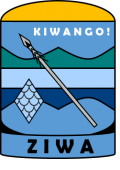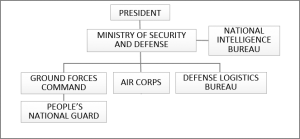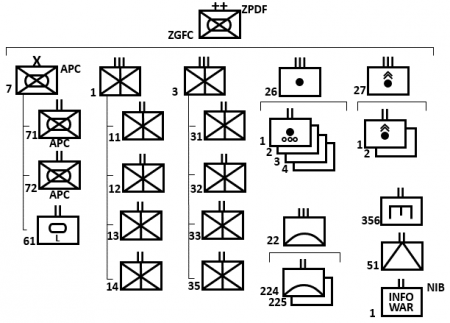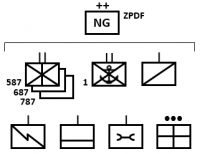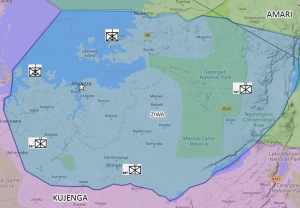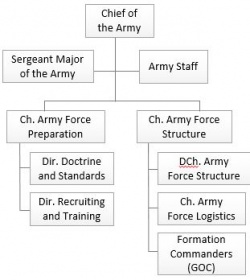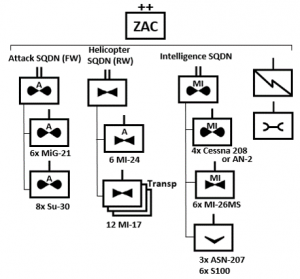Military: Ziwa
DATE Africa > Ziwa > Military: Ziwa ←You are here
The Ziwa People’s Defense Force (ZPDF) is the state military of the Republic of Ziwa. Its structure and focus has adapted over the last decade alongside the country’s economic development. The ZPDF consists of the Ziwa Ground Forces Command (ZGFC), Ziwa Air Corps (ZAC), and the National Guard. Ziwa’s military relations with its neighbors – Amari to the north and Kujenga to the south - is generally stable, despite sporadic low-level incidents along the border. The scope of border control operations has contributed to the forward deployment of dedicated maneuver elements and leveraging of former rebels to ensure the appearance of security.
Multiple threats exist to exploit Ziwa’s dependency on natural resources and external power generation and transmission. Brutal militants in the northeast mountain area (“The Watasi Gang”) and pockets of ethnic rebels throughout the country continue to plague stability and keep the military at continually high operational tempo. Although both Kujenga and Amari have active security agreements with Ziwa, rumors persist of covert support to the rebels by both countries. Another key role of the ZPDF is support to reducing criminal smuggling and trafficking of arms and humans through the country’s borders. The ZGFC and National Guard both have resources dedicated to this task. Defense spending and percentage of GDP included over the last five years averaged 1% of GDP. (Figures from CIA World Fact book.)
| Amari | Kujenga | Nyumba |
|---|---|---|
|
|
|
Ziwa National Command Authority
Military branches of the Ziwa People’s Defense Force (ZPDF) receive their authority via a civilian control and structure. The Ziwan Ministry of Security and Defense (MoSD) exercises overall control of the application of all instruments of national power to plan and carry out the national security strategy.National Strategic Goals
Ziwa’s defense policy has evolved from the previous regime’s emphasis on the need to defend itself against any external aggression. Over the last two decades it has also recognized that the threat to a country’s stability and economic progress can be internal. The mission of a nation’s security and defense forces are to ensure security by effectively implementing the nation’s policies on internal and external security. Its experience in suppressing rebellion within its borders led to internal defense policies that have been criticized for complying with only the letter of international agreements. Ziwa believes its economic progress, political power, and regional prestige are imperiled without a modern military power to secure them. The forces are designed and structured with these objectives in mind:
- Maintain internal stability and prevent internal security issue from destabilizing political and economic gains
- Support regional cooperation and develop stable international military relations
- Ensure and support beneficial use of Ziwan land and lake resources
- Enforce territorial integrity and maintain border security
- Defeat armed militants that threaten internal security and inhibit free trade and tourism.
Security and defense policy dictates that the forces should be held in operational readiness and their organization, equipment and procedures for exercising command and control should be tailored towards meeting the role and missions of the forces in peacetime, national emergency or crisis and in war.
Ziwa’s military forces must be used to influence perceived potential threats across the borders or otherwise. Modernizing and updating of the forces to cater for contingencies is essential and an ongoing program across all services.
Ziwa Ground Forces Command (ZGFC)
The Ziwa Ground Forces Command (ZGFC) is responsible for all ground combat and security patrol operations. Generally regarded as a competent ground force when conducting operations, military units in garrison have sometimes reflected their government’s level of corruption. There are approximately 33,600 ground forces on active duty, including the National Guard. No formal reserve capability exists. Forces are generally arrayed in rotation along Ziwa’s borders with non-deployed forces remaining in garrison bases.
Doctrine and Tactics
Ziwan military doctrine in similar to that of its neighbor, Kujenga, in that forces are deployed to stabilize and respond to security incidents. Heavier maneuver forces and/or air support may then be deployed to augment in-contact forces and provide decisive engagement as needed. While Ziwa has a fairly capable array of ground assets, commanders prefer to leverage their robust indirect fire capabilities – particularly in sparsely-populated areas.
Ziwan ground forces have modernized to a point, but their command doctrine retains legacy elements from prior to the force restructuring of the last two decades.
Composition
Maneuver battalions are Ziwa’s basic combat unit, with most being able to operate semi-independently. The ZGFC routinely adjusts its task organization based on mission requirements or perceived changes to threat conditions. The motorized regiments are rotated to designated security missions, with heavy forces and artillery allocated per mission requirements. The remainder of the forces are generally maintained at installations near Usagara and Geita.Primary Formations:
- 7th Mechanized Brigade
- 1st Motorized Regiment
- 2nd Motorized Regiment
- 26th Artillery Regiment
- 27th Rocket Regiment
- 22nd Air Defense Regiment
- 1st Information Warfare Battalion
- 356th Engineer Battalion
- 51st Antitank Battalion
Paramilitary Forces
Ziwa People’s National Guard (ZPNG). The National Guard is the state paramilitary security force of Ziwa. They are responsible for maintaining order and security along the Ziwan border with Kujenga and on Lake Victoria. They are generally regarded as capable of conducting area security and stability operations. The motorized units of the National Guard are arrayed across the Ziwa-Kujenga border, while the Marine Battalion has responsibility on the lake.A large portion of the National Guard’s approximately 3800 personnel is comprised of former rebel fighters from the border regions. Intended as a good will gesture, this strategy has been met with mixed results. Their knowledge of the terrain and local dynamics has been a significant benefit, but lingering grudges can create conflict.
The National Guard’s equipment is older than that of the primary ground forces – likely Tier 3, even 4. Differing levels of discipline within the ranks of the National Guard lead to a wide range of readiness. Where some units have been meticulous and even improved the vehicles to a Tier 2 condition, others have allowed them to fall into disrepair and resigned to mostly pedestrian operations.Many of the command positions and most of the signal unit are staffed by regulars from the ZGFC. The command and control systems are generally most sophisticated and kept in better repair to enable management across distances. They are likely Tier 2.
The National Guard’s Marine Battalion (MARBAT) is the only element in the ZPDF with a maritime capability. Its mission is to maintain safety and security on Lake Victoria and support lake port security operations. It has little offensive capability, but conducts regular patrols and courtesy inspection on the lake. Like the other National Guard units, it is staffed largely by former rebels, but is generally more professional and has a more positive reputation.
See also TC 7-100.2: Opposing Force Tactics, Chapter 15, Special Purpose Forces and Commandos.
Training and Readiness
The military fills the ranks of both its regular forces and the National Guard through an all-volunteer recruiting program. Reductions in regular force recruiting and retention levels were expected due to Ziwa’s economic growth, but personnel levels from Ziwa’s ethnic minorities and former rebels remain strong. Recruits receive basic military skills training at the Ziwa National Training Center near Usagara, with advanced skill training delivered either as additional training at the center or as on-the-job training (OJT). Ziwa relies heavily on peacekeeping rotations to solidify and expand individual and small unit capabilities.
Overall readiness and unit-level capabilities are generally better in the regular forces than National Guard units. The ranks of former rebels soldiers often receive waivers for training and may subsequently revert to their previous, often aggressive, small unit techniques if not intentionally enculturated into the wider force. Reporting has placed the regular force readiness at approximately 70-80%. Readiness in the National Guard varies, but is assumed to be slightly less than the regular force. National Guard units in the outlying areas, and those dominated by former rebels, have a history of modifying or cannibalizing their issued equipment based on their perceived local requirements.
Weapons and Equipment
The weapons and equipment of the ZPDF are mostly Tier 2 capabilities, with niche Tier 1 in much of its communications elements. The National Guard is distinctly less capable, with most of its equipment being Tier 3 and even some Tier 4 systems, although units may modify equipment to make it more capable. Equipment is generally purchased or acquired through trade agreements from Donovia or Olvana, with only a few categories from other producers.
The 61st Tank Battalion functions as a special presidential guard and has a significant allocation of Tier 1 equipment acquired through high-visibility military sales with Olvana. Although more capable than the bulk of the ZGDF, these are largely for regional prestige and not likely to be used except for capital defense.
Functional Capabilities
Command and Control
Ziwa’s history of confronting rebellion within its borders has created a culture in which defense-related policies and even brigade or regiment-level command directives are managed by the Ministry of Defense Headquarters at Mwanza. Despite the sometimes cumbersome information flow, military commanders retain a fair amount of autonomy within their assigned missions. Cynicism and distrust remains high throughout the Ziwa People’s National Guard (ZPNG), but frequent command and staff rotations have reduced simmering resentment.(See also TC 7-100.2: Opposing Force Tactics, Chapter 2, Command and Control)
Maneuver
The ZPDF maneuver forces maintain a relatively active rotational deployment schedule. Battalions assume active security, support, and refit roles throughout the year. They generally rotate within their parent regiments, augmented with additional armor, artillery, and other assets task organized as needed. As security requirements allow, ZPDF maneuver elements will be used as part of Ziwa’s peacekeeping or humanitarian contribution. Maneuver element are most often used to present an overwhelming deterrent to quell nascent crises or to contain problem situations until indirect fire assets can be utilized. (See below: “[[#Fire Support|Fire Support]]”)
Air Defense
The battalions of Ziwa’s 22nd Air Defense Regiment have a similar rotation scheme as the maneuver forces, with a primary mission of key facility protection in the capital and lake districts. Up to a battalion-sized force may be used to protect indirect fire assets – particularly long range MRL and artillery supporting maneuver forces in the active security role.
Ziwa has invested significant resources in integrating its air defense systems. This effort ranges from purchase of new systems to retrofitting older ones. Many maneuver elements have been augmented with physical and electronic air defense deception assets to further enhance survivability of these systems.
All maneuver battalions’ organic air defense capabilities are generally limited to MANPADS. Units frequently train to receive and send queuing communications to enhance responsiveness and accuracy of non-networked systems.
(See also TC 7-100.2: Opposing Force Tactics, Chapter 11, Air Defense)
INFOWAR
Ziwa’s military information warfare capabilities are closely linked to government capabilities. Both government and military prefers to control and direct the majority of INFOWAR assets at the national level. Military officials have stated publicly that they do not perceive a significant threat from their neighbors, but rely on their capabilities to maintain situational awareness.
Intelligence and INFOWAR-related capabilities supporting ZPDF forces will likely focus on maintaining situational awareness of opposing key military leaders, while retaining the capability to disrupt communications and interfere with threat decision-making capacity. Both tactical and space-based assets will impact threat GPS-reliant navigation and munitions. Ziwa has spent the last decade developing both an offensive and defensive cyber capability. The program leverages both domestic technical capabilities, as well as those of foreign actors – particularly North Torbia.
Ziwa has invested in significant improvements in unmanned aerial vehicles (UAV). Although much of the public information portrays the UAV advancements as related to the government’s unmanned safety and public health service programs, Ministry of Defense testing of advanced individual and swarm UAVs has been leaked to online sources.
(See also TC 7-100.2: Opposing Force Tactics, Chapter 7, Information Warfare) and Ziwa: Information
RISTA
The ZPDF reconnaissance, intelligence, surveillance, and target acquisition (RISTA) doctrine centers on the ground forces of the National Guard deployed across the border regions. This generally consists of presence patrols, surveillance, and coordination with intelligence personnel for development of human intelligence (HUMINT). Its ground reconnaissance is supported by advanced intelligence and INFOWAR capabilities allocated and managed by the Ziwan National Intelligence Bureau (NIB). This arrangement integrated Ziwan RISTA with its INFOWAR capabilities and doctrine.
The Ziwan Air Corp (ZAC) maintain most of the electronic warfare (EW) capabilities, which consist of integrated radar warning and RF countermeasures. Similarly, the 22nd Air Defense Regiment of the ZGFC is allocated systems to support early warning and target detection. The ZAC maintains a close relationship with the NIB to facilitate integration of the rapidly developing Ziwan space-based imagery capability. This capability has been criticized for alleged surveillance on Ziwan citizens, rather than on potential threats.
Ziwa is rapidly and aggressively adopting open source information research and analysis to improve intelligence capabilities. This has been a joint development project between the Ministry of Defense and prominent Ziwan universities.
Human intelligence continues to provide the majority of external data collection and a balanced share of internal intelligence.
Ziwa has no established MASINT systems but recent purchase of aerostat-based systems for border and regional surveillance.
See also TC 7-100.2: Opposing Force Tactics, Chapter 7, Information Warfare and Ziwa: Information
Fire Support
Ziwa views its artillery and rocket forces as key to its ability to maintain order and security within its borders. Rather than directly assigning indirect fire (IDF) assets to its motorized battalions, Ziwa prefers to maintain their IDF inventory at installations closer to the capital. It may temporarily attach assets to maneuver units as security requirements dictate. When deploying forward in support of maneuver forces, IDF systems will be supported by air defense assets.
Multiple rocket launcher systems are less likely to deploy with maneuver units as their ranges and garrisons allow support across much of the Ziwan territory. Exceptions in the past include operations to put down rebellion in the northeastern mountainous region.
Similar to its air defense upgrades, Ziwa has invested heavily in technical capabilities that increase the accuracy, lethality, and integration of the entire spectrum of fire support systems. Ziwa has not pursued a modern missile program. Rumors of upgrading and refitting of legacy pre-regime systems have been reported, but are likely unfounded.
(See also TC 7-100.2: Opposing Force Tactics, Chapter 9, Indirect Fire Support)
Protection
The ZPDF takes substantial effort to protect its critical assets and capabilities. The presumed capabilities of their neighbors, combined with the Ziwan preference for centralizing many of its critical intelligence and military assets has required a full range of physical and electronic protection measures.
Critical information and intelligence capabilities are protected in hardened facilities near the capital, while military assets rely on physical, electronic, and cyber protection. ZPDF combat units incorporate camouflage, force concealment, and use of decoys into their training. Elements of the ZPDF’s engineer battalion may be task organized to support specific requirements. When not specifically tasked, the engineer capabilities support maneuver units’ mobility and protection requirements.
Landmines from previous conflicts in the region have been used in improvised devices by rebels within Ziwan borders. ZPDF and National Guard soldiers train regularly on explosive hazard awareness. At least a quarter of the soldiers have participated in humanitarian demining operations in the region and worldwide.
(See also TC 7-100.2: Opposing Force Tactics, Chapter 12, Engineer Support)
Logistics
Ziwa centrally manages military materiel through its Defense Logistics Bureau (DLB), headquartered in Mwanza. Foreign supplies and equipment arrive for processing via air or rail. Meticulous record-keeping and modern automated systems allow the DLC to push standard supplies to military units with little interference. Commanders request variance through their staff to the DLC. Temporary remote depots may be established if commanders request it or secure resupply is at risk of compromise.
CBRNE
Ziwa does not have a confirmed offensive chemical warfare capability, nor is it part of their warfighting doctrine. All personnel receive a basic chemical first aid training. Emergency responders in all cities have more advanced capabilities for mass casualty care.
Ziwa Air Corps (ZAC)
The Ziwa Air Corps (ZAC) is a small but capable force with primary focus supporting ground forces, providing strategic deterrence, and enabling national intelligence efforts.
The main base is near Mwanza and was built by mostly Olvanan contractors in the late 1990s. The base is a multi-stage project that included runways, taxiways, extensive shelter and ordnance storage facilities, a headquarters facility and a large complex of living quarters and support buildings. Civilian airports and airfields may be used by military forces during times of national emergency, as authorized by the president.
The intelligence platforms of the ZAC are attached, but personnel and special technical assets remain under control of the National Intelligence Bureau.
Air Corps Size and Structure
The ZAC fields an estimated 645 personnel that operate approximately 18 fixed wing aircraft, 22 helicopters, and an estimated 9 unmanned aerial vehicles. ZAC aircraft operate primarily from Air Station Mwanza, although standing national policy authorizes military use of civil air infrastructure and facilities. Fighters and intelligence-related platforms will operate from secure facilities at Mwanza.ZAC intelligence personnel also have the responsibility to coordinate military application of Ziwa’s developing GPS and space-based intelligence capabilities.
Air Corps Doctrine and Tactics
Political and military leaders have reiterated the fundamental principle was that the ZAC would undertake a preemptive attack if the security of the state is endangered. It is unknown whether this extends to internal strikes. Due to Ziwan political desires, justification for preemptive attacks would need to be clearly articulated. The Air Corps regularly trains on ground support and interception missions. The ZAC prefers to conduct disruption missions against potential threats and lines of communication. Pilots have received training in conducting sensitive intelligence border operations with the assumption of communications or navigational interference.
Air Corps Weapons and Equipment
One of the fundamental elements of Ziwa’s air capability development is to gain the support of at least the sympathy of one large or middle power – in practice, usually Olvana or Donovia. They have also purchased or participated in military sales programs of a variety of countries, which gives the ZAC an odd mix of equipment sources. The ZAC aircraft inventory is generally Tier 2 to Tier 3 - based on technology from 15 to 30 years ago. Aircraft converted for intelligence purposes may have been fitted with niche Tier 2, or in some cases, Tier 1 systems. Most of the ZAC aircraft are capable of conducting 24-hour operations in all weather. The equipment is generally Donovian in origin, with some Olvanan variants possible.Ziwa Air Corp (ZAC)
Air Corps Training and Readiness
Ziwan aircraft inventory is kept at a relatively high state of repair and readiness – as high as 80%. ZAC emphasis on maintaining existing aircraft while investing in enabling technologies have kept its systems operating at a high level. Pilots receive training from a variety of sources, particularly Donovia. Pilots receive sufficient live and simulated air missions to maintain proficiency.

